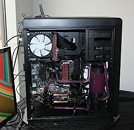Wednesday, June 3rd 2015
Phanteks Unveils PSU Power Splitter for Enthoo Mini XL
Phanteks' highly desirable dual-motherboard case, the Enthoo Mini XL, was displayed with a new PSU power splitter accessory, at Computex. Simply put, this accessory lets you multiply the 24-pin ATX and 8-pin EPS connectors of your PSU, so you can run both the ATX and ITX motherboards with a single PSU, with the added freedom of shutting down and powering up either board without affecting the other. The splitter takes is 'smart' in this way. It takes 24-pin and 8-pin inputs from the real PSU, and to the end user, behaves like two PSUs, so both "systems" (motherboards) can be turned on or off at whim.


5 Comments on Phanteks Unveils PSU Power Splitter for Enthoo Mini XL
I've been keeping an eye on such things for a while now, because of my silly watercooled PC plan...
The amount of sunk current would be proportional to the difference between the effective voltage at the load end (lets say on the motherboard end of the ATX connector) and the voltage "seen" by the PSUs on the splitter. The current sinking capacity is the same as the current output capacity, so if a PSU can output 30A on a particular rail, that is also how much it can sink into itself.
Put simply, you cannot load-balance between different PSUs by having both connected to the same load. You would need some kind of electronics in place to block the current flow between PSUs.
I should take apart a server PSU section at some point to see how it's done...